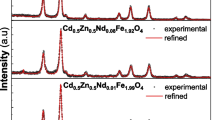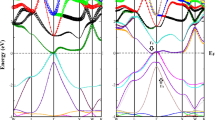Abstract
Both nominally undoped and 1%Sr-doped langasite were found to exhibit acceptor behavior and correspondingly mixed ionic-electronic conductivity under experimentally accessible conditions. At high pO2, the conductivity of nominally undoped langasite was pO2-independent (ionic behavior) but became increasingly pO2-dependent (n-type behavior) under reducing conditions. The substitution of strontium on lanthanum sites, increased the ionic and introduced a p-type electronic conductivity behavior at the highest pO2’s, while completely depressing the n-type electronic conductivity – observations consistent with predictions of the proposed defect model based on oxygen vacancy formation in response to negatively charged acceptor impurities.
Sr-doped langasite was found to have a higher activation energy for oxygen ion transport (1.27 ± 0.02 eV) than nominally undoped langasite (0.91 ± 0.01 eV). This difference could not be successfully explained by applying a simple defect association model but required the assumption of long range defect interactions.
Using the defect model, a number of key equilibrium constants (reduction (5.7 ± 0.06 eV), oxidation (2.18 ± 0.08 eV), electron-hole generation (3.94 ± 0.07 eV), and defect mobilities (oxygen vacancies and holes) were derived and summarized.
Similar content being viewed by others
References
J.W. Mrosk, C. Ettl, L. Berger, P. Dabala, H.J. Fecht, G. Fischerauer, J. Hornsteiner, K. Riek, E. Riha, E. Born, W. Werner, A. Dommann, J. Auersperg, E. Kieselstein, B. Michel, and A. Mucha, SAW sensors for high temperature applications. Proceedings of 24th Annual Meeting of IEEE Industrial Electronics Society, IECON 1998, 1998: p. 2386–2390.
D. Damjanovic, Materials for high temperature piezoelectric transducers, Current Opinion in Solid State & Materials Science, 3, 469–473 (1998).
R. Mital, J. Li, S.C. Huang, B.J. Stroia, and R.C. Yu, Diesel exhaust emissions control for light duty vehicles. SAE Technical Paper Series (2003-01-0041), 2003.
M.S. Brogan, A.D. Clark, and R.J. Brisley, Recent progress in NOx trap technology. SAE Technical Paper Series (980933), 1998.
Y.-W. Kim, J. Sun, I. Kolmanovsky, and J. Koncsol, A phenomenological control oriented lean NOx trap model. SAE Technical Paper Series (2003-01-1164), 2003.
H. Fritze, H.L. Tuller, H. Seh, and G. Borchardt, High temperature nanobalance sensor based on langasite. Sensors and Actuators B, 76, 103–107 (2001).
H. Seh, H.L. Tuller, and H. Fritze, Langasite for high-temperature acoustic wave gas sensors, Sensors and Actuators B, 93, 169–174 (2003).
H. Seh, H.L. Tuller, and H. Fritze, Electrical conductivity prediction in langasite for optimized microbalance performance at elevated temperatures, Proceedings of MRS Symposium 756, 175–180 (2003).
H. Seh, H.L. Tuller, and H. Fritze, Defect properties of langasite and effects on BAW gas sensor performance at high temperatures, J. European Ceramic Society, 24, 1425–1429 (2004).
H. Seh and H.L. Tuller, Defect chemistry of donor-doped langasite. Submitted to Journal of Electroceramics (2004).
H. Seh, H.L. Tuller, and H. Fritze, Impact of defect chemistry on langasite resonator operations at high temperatures, Submitted to J. Electroceram. (2004).
S.R. Rotman, R.P. Tandon, and H.L. Tuller, Defect-property correlations in garnet crystals: the electrical conductivity and defect structure of luminescent cerium-doped yttrium aluminum garnet, J. Appl.Phys., 57(6), 1951–1955 (1984).
S.R. Rotman, H.L. Tuller, M. Roth, and A. Linz, Defect property correlations in garnet crystals. II. Electrical conductivity and optical absorption in Ca3Al2Ge3O12, J. Appl. Phys., 57(12), 5320–5324 (1985).
N.W. Ashcroft and N.D. Mermin, Solid State Physics (Saunders College Publishing, 1976).
W.D. Kingery, H.K. Bowen, and D.R. Uhlmann, Introduction to Ceramics. (John Wailey & Son, 1976).
Y.-M. Chiang, D.B. III, and W.D. Kingery, Physical Ceramics (John Wiley & Sons, Inc, 1997).
D.M. Smyth, The Defect Chemistry of Metal Oxides (Oxford University Press, 2000).
H.L. Tuller, Mixed conduction in nonstoichiometric oxides, in Nonstoichiometric Oxides, O.T. Sorensen (ed.). (Academic Press, New York, 1981), p. 271–335.
D.Y. Wang, D.S. Park, J. Griffith, and A.S. Nowick, Oxygen-ion conductivity and defect interactions in yttria-doped ceria, Solid State Ionics, 2, 95–105 (1981).
H.L. Tuller, Oxygen ion conduction and structural disorder in conductive oxides, J. Physi. and Chemis. Sol., 55(12), 1393–1404 (1994).
M. Schulz, H. Fritze, H.L. Tuller, and H. Seh, Diffusion related implications for langasite resonator operation, IEEE Transactions on Ultrasonics, Ferroelectrics, and Frequency Control, 51(11), 1381–1387 (2004).
B.V. Mill and Y.V. Pisarevsky, Langasite-type materials: from discovery to present state, IEEE/EIA International Frequency Control Symposium and Exhibition, 133–144 (2000).
R. Merkle and J. Maier, Defect association in acceptor-doped SrTiO3: Case study for Fe′Ti V0 and MnTi⁗V0, Physical Chemi. Chem. Phys., 5(11), 2297–3303 (2003).
S.A. Kramer and H.L. Tuller, A novel titanate-based oxygen ion conductor: Gd2Ti2O7, Solid State Ionics, Diffusion & Reactions, 82(1-2), 15–23 (1995).
Y. Taehwan and H.L. Tuller, Ionic conduction and disorder in the Gd2Sn2O7 pyrochlore system, Solid State Ionics, Diffusion & Reactions, 86–88(1), 177–182 (1996).
M.F. Dubovik, K.A. Katrunov, and T.I. Korshikova, The nature of langasite crystal’s coloration, IEEE International Frequency Control Symposium, 638–641 (1995).
T. Minami, New n-type transparent conducting oxides, MRS Bulletin, 25, 38–44 (2000).
Author information
Authors and Affiliations
Rights and permissions
About this article
Cite this article
Seh, H., Tuller, H.L. Defects and transport in langasite I: Acceptor-doped (La3Ga5SiO14). J Electroceram 16, 115–125 (2006). https://doi.org/10.1007/s10832-006-4081-x
Received:
Revised:
Accepted:
Issue Date:
DOI: https://doi.org/10.1007/s10832-006-4081-x




